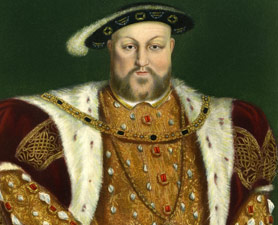King Henry VIII’s Madness Explained
Source: news.discovery.com
Could a genetic disorder and a rare blood type explain Henry VIII’s health problems, his wives’ miscarriages, and even his madness? Among a long list of personality quirks and historical drama, Henry VIII is known for the development of health problems in mid-life and a series of miscarriages for two of his wives. In a new study, researchers propose that Henry had an X-linked genetic disorder and a rare blood type that could explain many of his problems.
Among a long list of personality quirks and historical drama, Henry VIII is known for the development of health problems in mid-life and a series of miscarriages for two of his wives. In a new study, researchers propose that Henry had an X-linked genetic disorder and a rare blood type that could explain many of his problems.By suggesting biological causes for significant historical events, the study offers new ways to think about the infamous life of the notorious 16th-century British monarch, said Catarina Whitley, a bioarchaeologist who completed the research while at Southern Methodist University.
"What really made us look at Henry was that he had more than one wife that had obstetrical problems and a bad obstetrical history," said Whitley, now with the Museum of New Mexico. "We got to thinking: Could it be him?"
Plenty of historians have written about Henry’s health problems. As a young man, he was fit and healthy. But by the time of his death, the King weighed close to 400 pounds. He had leg ulcers, muscle weakness, and, according to some accounts, a significant personality shift in middle age towards more paranoia, anxiety, depression and mental deterioration.
Among other theories, experts have proposed that Henry suffered from Type II diabetes, syphilis, an endocrine problem called Cushing’s syndrome, or myxedema, which is a byproduct of hypothyroidism.
All of those theories have flaws, Whitley said, and none address the monarch’s reproductive woes. Two of his six wives -- Ann Boleyn and Katherine of Aragon -- are thought to have suffered multiple miscarriages, often in the third trimester.
To explain those patterns, Whitley and colleague Kyra Kramer offer a new theory: Henry may have belonged to a rare blood group, called Kell positive. Only 9 percent of the Caucasian population belongs to this group.
When a Kell positive man impregnates a Kell negative woman, there is a 50 percent chance of provoking an immune response in the woman’s body that attacks her developing fetus. The first baby of a Kell positive father and Kell negative mother is usually fine. But some of the baby’s blood will inevitably get into the mother’s body -- either during development or at birth, leading her to produce antibodies against the baby’s Kell antigens.
As a result, in subsequent pregnancies, babies may suffer from extra fluid in their tissues, anemia, jaundice, enlarged spleens, or heart failure, often leading to miscarriage between about 24 and 28 weeks of pregnancy.
Ann Boleyn is a classic example of this pattern, Whitley said. According to some accounts (and there is still much dispute about the details, including how many pregnancies there actually were), Elizabeth -- Anne’s first daughter with Henry -- was born healthy and without complications. But her second and third pregnancies miscarried at about month six or seven.
Katherine of Aragon carried as many as six pregnancies. Only her fifth led to the birth of a live and health baby, a daughter named Mary.
In addition to Henry’s problematic blood type, the researchers propose that he also had a rare genetic disorder called McLeod syndrome. Carried on the X-chromosome, the disease generally affects only men and usually sets in around age 40 with symptoms including heart disease, movement disorders and major psychological symptoms, including paranoia and mental decline.
The disease could explain many of Henry’s physical ailments, the researchers propose. It could also explain why he may have become more despotic as he grew older and why he shifted from supporting Anne to having her beheaded.
"This gives us an alternative way of interpreting Henry and understanding his life," Whitley said. "It gives us a new way to look at the reasons he changed."
Without any genetic evidence, however, there’s no way to know for sure whether the new theories are right, said Retha Warnicke, a historian at Arizona State University and author of The Rise and Fall of Anne Boleyn: Family Politics at the Court of Henry VIII.
Other conditions could explain the miscarriages, she said. Until the late 19th-century, midwives did not wash their hands. And in Henry’s time, up to half of all children died before age 15.
As for Henry’s woes, dementia could explain his personality shifts, she added. Lack of exercise -- after an active youth -- combined with a hearty appetite could have led to his obesity and related ills.
"Could is the big word," Warnicke said. "It’s an interesting theory and it’s possibly true, but it can’t be proven without some clinical evidence, and there is none."
Article from: news.discovery.com






















